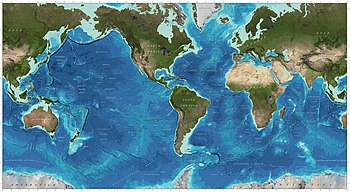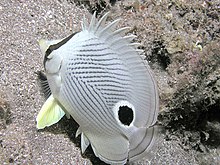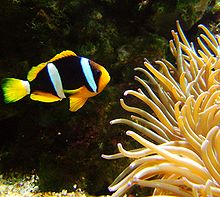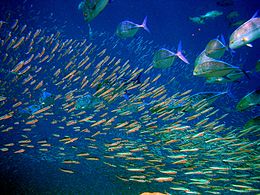Coastal fish
This article needs additional citations for verification. (February 2021) |

Coastal fish, also called inshore fish or neritic fish, inhabit the sea between the
Coastal fish are the most abundant in the world.
Coastal habitats

Coastal fish are found in the waters above the
Nearshore fish
Nearshore fish, sometimes called littoral fish, live close to the shore. They are associated with the
, or rocky or sandy bottoms, usually in shallow waters less than about 10 m (33 ft) deep.Intertidal fish
Intertidal fish are fish that move in and out with the
The
Some rock pool fish which are temporary residents include the
- The common blenny, also known as the shanny, is found in northern temperate waters. They hide under rocks and in crannies in rock pools when the tide is out. They feed on green seaweed and invertebrates such as barnacles. They can crawl on dry land, using their paired fins. About 16 cm (6.3 in) long, they have smooth skin, without scales, and are covered with soft slime. The slime prevents them drying if they are stranded on a shore between tides. So long as their skin stays moist, they can breathe out of water. They are sometimes called "sea frogs" because they bask in the sun on weeds outside the water, and like frogs, jump to safety when disturbed. They can change their colour to match their surroundings. The female lays eggs in crevices or under stones and the male guards them until they hatch. In the winter, when storms can be severe, they move out of their rock pools into the shallows. The common blenny is bold with strong teeth, and will bite humans if it feels threatened.[6]
- The rock goby is a small fish, about 12 cm (4.7 in), found in northern temperate waters. It is coloured black with white blotches, and hides under stones and amongst seaweed. It is a temporary resident of rock pools when the tide is out. The female rock goby lays eggs on the underside of rocks and shells and then leaves them. The male guards the eggs until they hatch. First-year rock gobies often visit rock pools in winter when the older fish have left.
-
Australianblenny
-
Long-spined sea scorpion[7]
-
Smoothlumpsuckerinflated in a defensive response
- The long-spined sea scorpion, a small stout fish which grows about 29 cm (11 in) long, is another temporary resident of rocky pools. They have large black eyes, a large mouth, and four long spines—two on each side on the gill cover—that stick out when the fish is removed from the water. They also have an organ like a finger on each side of their mouths which helps them catch prey. Because of their broad heads, they are also called "bullheads". They have a variety of effective camouflaged colours ranging from shades of browns with cream blotches, to orange and red with white blotches. They can also change their body colour to match their surroundings. They are found around the coasts of Northern Europe in shallow rocky waters hiding amongst seaweed. They are also found in rock pools and sometimes in waters 30 m (98 ft)deep. Long-spined sea scorpions lay eggs amongst seaweed or attached to rock crevices. The young hatch after two or three weeks, and go through several development stages before maturing into adults.
- Lumpsuckersare found in temperate northern waters. They live on the seafloor, and are temporary residents of rocky pools in late winter and early spring when they spawn. The body of the lumpsucker is scaleless and covered with small lumps. They have a large sucking disc on their underside which they use to cling to surfaces. They are normally a blue to slate-grey colour, and are effectively camouflaged to look like stones. They are portly, nearly spherical, poor swimmers, reaching lengths up to 50 cm (20 in). After the female lumpsucker lays eggs, the male takes over, clamping itself to a rock where it guards the eggs. When they hatch, lumpsuckers look like tiny tadpoles. They remain in shallow water and rock pools, hiding amongst seaweed and rocks, until they grow up.
Estuarine fish
Fishes that spend time in
River estuaries form important staging points during the migration of anadromous and catadromus fish species, such as salmon and eels, giving them time to form social groups and to adjust to the changes in salinity. Salmon are anadromous, meaning they live in the sea but ascend rivers to spawn; eels are catadromous, living in rivers and streams, but returning to the sea to breed. Besides the species that migrate through estuaries, there are many other fish that use them as "nursery grounds" for spawning or as places young fish can feed and grow before moving elsewhere. For example, herring and plaice are two commercially important species that use the Thames Estuary for this purpose.
Coral reef fish
In tropical waters, coral reef fish live amongst or in close relation to coral reefs. Coral reefs form complex ecosystems with tremendous biodiversity. Coral reef fish can be particularly colourful and interesting to watch. Hundreds of species can exist in a small area of a healthy reef, many of them hidden or well camouflaged. Reef fish have developed many ingenious specialisations adapted to survival on the reefs. Coral reefs occupy less than one per cent of the surface area of the world oceans, yet they provide a home for 25 per cent of all marine fish species.
Coral reefs often depend on other habitats in the surrounding area for the supply of nutrients, such as seagrass meadows and mangrove forests. Seagrass and mangroves supply dead plants and animals which are rich in nitrogen and also serve to feed fish and animals from the reef by supplying wood and vegetation. Reefs in turn protect mangroves and seagrass from waves and produce sediment for the mangroves and seagrass to root in.[11]


Other nearshore fish

Other nearshore or shallow water fish live near the shore in depths of less than 10 metres. They occupy the areas over sandy or rocky bottoms, and can be associated with seagrass meadows and kelp forests. They can be divided into demersal fish and pelagic fish. Demersal fish live on or near the sea floor, while pelagic fish live in the water column away the sea floor.
Examples of such shallow water demersal fish, found in both tropical and temperate waters around the world, are triplefins, seahorses, wrasse and flounder. As demersal fish, all these fish spend most of their time on or near the sea floor.
- groundfish, found on muddy and sandy sea floors. In many species both eyes lie on one side of the head, one or the other migrating through and around the head during development. Some species face their "left" side upward, some face their "right" side upward, and others face either side upward. Some flatfish can camouflage themselves on the ocean floor.
- Wrasse are a large family of mainly small fish, usually less than 20 centimetres (7.9 in) long. Most wrasse are loners that prefer habitats such as coral reefs and rocky shores. They live close to the substrate, eating small invertebrates and almost anything else that lurks on the bottom. Many are brightly coloured. They have thick lips and use their sharp teeth to pick small creatures off the rocks. Many smaller wrasses follow the feeding trails of larger fish, picking up invertebrates disturbed by their passing.[12]: 211
- coral reefs and rocks, usually in shallow, clear sunlit waters such as lagoons and seaward reefs. Triplefins have three dorsal fins(hence the name). They are small fish, usually less than six cm long. Brightly coloured, often for reasons of camouflage, they are nervous and retreat to rock crevices at any perceived threat.
- estuaries. They are camouflaged with murky patterns that blend into kelp and sea grass backgrounds. During social moments or in unusual surroundings, seahorses can turn on bright colours.
-
Seahorse
-
Flatfish
-
Cleaner wrasses working on adragon wrasse
Examples of shallow water pelagic fish, found in both tropical and temperate waters around the world, are grey mullet, sprats and garfish. As pelagic fish, all these fish spend most of their time living in the water column away the sea floor.
- The seine nets.
- The garfish is a long, slender fish, looking like a spear, which feeds on seagrass fragments, shrimps and crab larvae. In turn it is preyed on by larger fish and, since it is often near the surface, cormorants and gannets.
-
Grey mullet
Coastal pelagic fish
Plankton feeding
| marine food chain (typical) |
|---|
|
|
| ↓ |
| phytoplankton |
| ↓ |
| herbivorous zooplankton |
| ↓ |
| carnivorous zooplankton |
| ↓ |
|
|
| ↓ |
|
|


At the base of
Most filter-feeding pelagic fish found in coastal waters are small, silvery
Worldwide, there are five major coastal currents associated with upwelling areas: the
-
anchovies
-
Underwater video loop of a school of herrings migrating to their spawning grounds in the Baltic Sea
Predatory

Predatory pelagic fishes found on continental shelves worldwide in both tropical and temperate waters include
- Mackerel scom*
- grunt fishes (grunts are named for the sound they make grinding their teeth[12]: 184 ). They are bottom feeding pelagic fishes, with small mouths equipped with strong teeth adapted for handling small fishes and invertebrates with hard shells. Most do not exceed a size of about 30 cm (12 in), but some may grow to four times that length.[20]They often school, and will migrate between reefs. Larger fish enter estuaries and harbours.
- pilchard. Barracouta often hunt in schools near the bottom or midwater, and sometimes even near the surface at night.
-
Great barracuda and jacks
-
The yellowtail amberjack, pound for pound, is one of the hardest fighting fish in the ocean.
-
The largehead hairtail is a cutlassfish

- : 190
- trevally are fish of the family Carangidae. Found in most coastal waters, they are fast predatory fishes that hunt in the waters above reefs and in the open sea; some dig in the sea floor for invertebrates (some can also filter feed, such as the white trevally). The largest fish in the family, the giant trevally, grows up to 1.7 m in length; most fish in the family reach a maximum length of 25–100 cm. The family contains many important commercial and game fish, notably the Pacific jack mackerel and the other jack mackerels in the genus Trachurus. The type species of this genus is the Atlantic horse mackerel. Jack mackerels are an important inshore commercial species.
- Amberjacks are a group of nine species belonging to the genus Seriola within the family Carangidae. Mainly open water fish, they can follow small forage fish into estuaries and enclosed waters, where they will also hunt for crustaceans. Amberjacks are fast swimming and aggressive predators that often hunt in schools around offshore reefs. The yellowtail amberjack can reach 1.8 m in length and weigh 60 kilograms.
Demersal pelagic fish
Fish that live on or in close association with the sea floor are called demersal fish. This section discusses the coastal demersal fish that live on the continental shelf, but are living further from the coast and in deeper water than the nearshore fish discussed above.
Demersal fish are
which live on the sea bed. Benthic fish tend to be "flat", so they can lie on the bottom.- . Cod-like fishes are often found in large schools over sandy or muddy bottoms. They have a barbel (fleshy filament) on their lower jaw which they use to detect prey buried in the sand or mud. Some migrate to warm water in winter to spawn.
- John Dory are fishes of the genus Zeus. They have a widespread distribution and are typically found near the seabed in depths from 5 meters (16 feet). The John Dory grows to a maximum length of 65 cm (2.13 ft). Although it is a benthopelagic fish, its body is flat and it can hardly be seen from the front because it is so thin. It is a poor swimmer with long spines on the dorsal fin. It has a large dark eyespot on the side of its body which is used to confuse prey, which are scooped up in its big mouth.[23] Large eyes at the front of the head provide it with bifocal vision and depth perception, which are important for predators. The John Dory usually gets its food by stalking it then shooting out a tube in its mouth to capture its prey. It eats forage fish, and occasionally squid and cuttlefish. In turn, they are preyed on by sharks, like the dusky shark, and other large bony fish. They are normally solitary.
- Turbot and brill are benthic flatfish, resembling flounder and sole, but found in deeper offshore waters on the continental shelf.[24] They are brownish-green, with dark blotches on the turbot and mottling on the brill. They are fished by coastal trawlers.
-
The
-
Thefood fish.[27]
-
The red gurnard is a mail-cheeked fish found to depths of around 180 metres. They often grunt when captured as air is expelled from its air bladder.[28]
- caudal fins. Most species are less than 30 centimetres (12 in) in length, but the full size range of the order varies from the velvetfishes, which can be just 2 centimetres (0.79 in) long as adults, to the Lingcod, which can reach 150 centimetres (4.9 ft) in length.[12]
- Red gurnardare mail-cheeked fish. They use their large pectoral fins to rest on the bottom and to detect food.

- benthic carnivores, feeding on small fish and invertebrates. Examples are the redbanded weever, yellow weaver and blue cod. They are often caught in pots like crayfish.
- , which provides them with protection from predators and opportunities to scavenge the remains of the jellyfish's meals. The young of other species associate with large masses of floating kelp.
-
A speckledsand perch[31]perched on coral sand
-
The rudderfish (medusa fish
-
Atlantic wreckfish inhabit caves and wrecks. They are good game fish, reaching a maximum reported length of 210 cm (6.9 ft) and weight of 100 kg (220 lb).
- gill nets (in earlier times longlineswere used).
- Wreckfish are a family Polyprionidae of perciform fishes, found on the floor of the continental shelf and slope where they inhabit caves and shipwrecks (thus their common name). The Atlantic wreckfish is at depths between 40 and 600 m (130 and 1,970 ft). They are largely a solitary fish, though juveniles school below floating objects. Their diet includes large ocean cephalopods, crustaceans, and other bottom-dwelling fishes.
See also
- Coral reef fish
- Demersal fish
- Forage fish
- Marine habitats
- Moorish idol
- Monkfish
- NaGISA
- Pelagic fish
- Shoaling and schooling
- Weever
Notes
- ^ Moyle and Cech, 2004, page 585
- ^ a b Moyle and Cech, 2004, page 572
- ^ a b World The World Factbook, CIA. Retrieved 26 February 2010.
- ^ Continental shelf areas Archived December 2, 2008, at the Wayback Machine Earth trends. Retrieved 25 February 2010.
- ^ Froese, Rainer; Pauly, Daniel (eds.) (2010). "Penetopteryx nanus" in FishBase. March 2010 version.
- ^ Shanny (common blenny) Archived 2012-07-04 at the Wayback Machine BBC. Updated July 2005.
- ^ Froese, Rainer; Pauly, Daniel (eds.) (2010). "Cottus bubalis" in FishBase. March 2010 version.
- ^ Pritchard, D. W. (1967) What is an estuary: physical viewpoint. p. 3–5 in: G. H. Lauf (ed.) Estuaries, A.A.A.S. Publ. No. 83, Washington, D.C.
- ISBN 0-19-852508-7
- ^ Moyle and Cech, 2003, p. 50.
- ^ Greenpeace Book of Coral Reefs
- ^ a b c d e f g h i j k l
Johnson, G.D.; Gill, A.C. (1998). Paxton, J.R.; Eschmeyer, W.N. (eds.). Encyclopedia of Fishes. San Diego: Academic Press. ISBN 0-12-547665-5.
- ^ Froese, Rainer, and Daniel Pauly, eds. (2007). "Pomacentridae" in FishBase. July 2007 version.
- ISBN 978-0-87666-034-8.
- ISBN 978-0-471-25031-9.
- ^ Jenkins, A.P.; G.R. Allen (2002). "Neopomacentrus aquadulcis, a new species of damselfish (Pomacentridae) from eastern Papua New Guinea". Records of the Western Australian Museum. 20: 379–382.
- doi:10.11646/zootaxa.1671.1.2. Archived from the original(PDF) on 21 July 2011. Retrieved 1 March 2010.
- ^ Anderson, G (2003) Coral Reef Formation Marine Science.
- ^ ISBN 1-4051-1118-6
- ^ Porgy Encyclopædia Britannica. Retrieved February 23, 2010.
- ^ Pollnac, R.B. 1998 Aspects of the human ecology of the coral reefs of Discovery Bay. p. 141-199. In R.B. Pollnac (ed.) Rapid assessment of management parameters for coral reefs. Coastal Resources Center, University of Rhode Island. CMR 2205, ICLARM 1445.
- .
- ^ "John dory".
- ISBN 1-84309-666-8.
- ^ Froese, Rainer; Pauly, Daniel (eds.) (2010). "Boreogadus saida" in FishBase. March 2010 version.
- ^ Froese, Rainer; Pauly, Daniel (eds.) (2010). "Zeus faber" in FishBase. March 2010 version.
- ^ Froese, Rainer; Pauly, Daniel (eds.) (2010). "Psetta maxima" in FishBase. March 2010 version.
- ^ Walrond, Carl (2009) "Coastal fish - Fish of the open sea floor" Te Ara - the Encyclopedia of New Zealand. Updated 2 March 2009.
- ^ a b Grady, Denise Venom Runs Thick in Fish Families, Researchers Learn The New York Times 22 August 2006.
- ^ Froese, Rainer; Pauly, Daniel (eds.) (2010). "Uranoscopus sulphureus" in FishBase. March 2010 version.
- ^ Froese, Rainer; Pauly, Daniel (eds.) (2010). "Parapercis hexophtalma" in FishBase. March 2010 version.
References
- Elliott, Michael and Hemingway, Krystal (2002) Fishes in estuaries John Wiley & Sons. ISBN 978-0-632-05733-7.
- Humann, Paul and DeLoach, Ned (2008) Coastal Fish Identification: California to Alaska New World Publications Incorporated. ISBN 9781878348432.
- Moyle, PB and Cech, JJ (2004) Fishes, An Introduction to Ichthyology 5th Ed, Benjamin Cummings. ISBN 978-0-13-100847-2
- Hinrichsen D (1999) Coastal Waters of the World: Trends, Threats, and Strategies Island Press. ISBN 978-1-55963-383-3
- Mann KH (2000) Ecology of coastal waters: with implications for management (Vol 8 of Studies in ecology) Wiley-Blackwell. ISBN 9780865425507
External links
- Walrond, Carl. "Coastal fish" – Te Ara: The Encyclopedia of New Zealand (updated 23 November 2009)
- Marine Biology 2: Water layering and water movements
- Notes on Estuarine Fish Reproduction. Retrieved 20 February 2010.
- Estuarine Fish Kills in Morth Carolina. Retrieved 20 February 2010.
- Inshore marine fish





![Long-spined sea scorpion[7]](http://upload.wikimedia.org/wikipedia/commons/thumb/5/52/Long_Spined_Scorpion_Fish.jpg/120px-Long_Spined_Scorpion_Fish.jpg)









![The jolthead porgy is a porgi grunt[21]](http://upload.wikimedia.org/wikipedia/commons/thumb/9/96/Calamus_bajonado.jpg/120px-Calamus_bajonado.jpg)


![The polar cod is found further north than any other fish species. It frequents river mouths and feeds on plankton and krill. It is preyed on by narwhals, belugas, ringed seals and seabirds.[25]](http://upload.wikimedia.org/wikipedia/commons/thumb/7/74/Boreogadus_saida.jpg/180px-Boreogadus_saida.jpg)
![The John Dory is so thin it can hardly be seen from the front. The large eyespot on the side of its body confuses its prey.[26]](http://upload.wikimedia.org/wikipedia/commons/thumb/3/35/MacGillivray%2C_William_John_Dory.jpg/82px-MacGillivray%2C_William_John_Dory.jpg)
![The turbot is a large left-eyed flatfish usually found not too far from shore in sandy shallow waters. It is a prized food fish.[27]](http://upload.wikimedia.org/wikipedia/commons/thumb/8/84/Psetta_maxima_Luc_Viatour.jpg/162px-Psetta_maxima_Luc_Viatour.jpg)
![The red gurnard is a mail-cheeked fish found to depths of around 180 metres. They often grunt when captured as air is expelled from its air bladder.[28]](http://upload.wikimedia.org/wikipedia/commons/thumb/0/02/Helidonichthys_spinosus.jpg/120px-Helidonichthys_spinosus.jpg)
![A speckled sand perch[31] perched on coral sand](http://upload.wikimedia.org/wikipedia/commons/thumb/5/53/Parapercis_hexophtalma_1.jpg/167px-Parapercis_hexophtalma_1.jpg)







